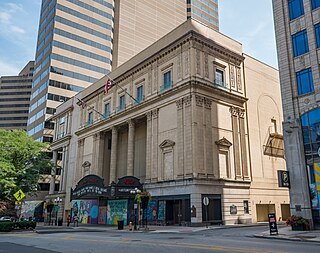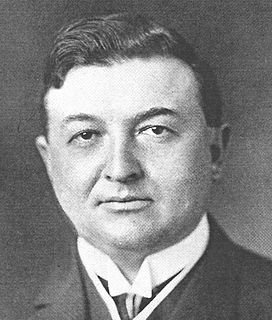
The Tennessee Theatre is a movie palace in downtown Knoxville, Tennessee. The theater was built in 1928 in the 1908 Burwell Building, considered Knoxville's first skyscraper. The theater and Burwell Building were added to the National Register of Historic Places in 1982, and the theater was extensively restored in the early 2000s. The Tennessee Theatre currently focuses on hosting performing arts events and classic films, and is home to the Knoxville Opera and the Knoxville Symphony Orchestra. The theater is managed by AC Entertainment.

A movie palace is any of the large, elaborately decorated movie theaters built between the 1910s and the 1940s. The late 1920s saw the peak of the movie palace, with hundreds opened every year between 1925 and 1930. With the advent of television, movie attendance dropped and many movie palaces were razed or converted into multiple screen venues or performing arts centers.

The Ohio Theatre is a performing arts center and former movie palace on Capitol Square in Downtown Columbus, Ohio. Known as the "Official Theatre of the State of Ohio", the 1928 building was saved from demolition in 1969 and was later completely restored. The theater was declared a National Historic Landmark in 1977 as one of the nation's finest surviving grand theaters.

The Warner Theatre is an Art Deco and French Renaissance-styled theater located in downtown Erie, Pennsylvania in the United States. It was listed on the National Register of Historic Places in 1982. The Warner was designed by Chicago-architects Rapp and Rapp and was opened in 1931. It was used as a movie theater until 1976, when it was sold to the City of Erie. In the early 1980s, Erie converted the theater to a performing arts center, which has become the focus of a downtown revival.

The Chicago Theatre, originally known as the Balaban and Katz Chicago Theatre, is a landmark theater located on North State Street in the Loop area of Chicago, Illinois, United States. Built in 1921, the Chicago Theatre was the flagship for the Balaban and Katz (B&K) group of theaters run by A. J. Balaban, his brother Barney Balaban and partner Sam Katz. Along with the other B&K theaters, from 1925 to 1945 the Chicago Theatre was a dominant movie theater enterprise. Currently, Madison Square Garden, Inc. owns and operates the Chicago Theatre as a performing arts venue for stage plays, magic shows, comedy, speeches, sporting events and popular music concerts.

The Grand Opera House is an opera house located at the corner of 8th and Iowa Streets in Dubuque, Iowa that was built in 1890. It was listed on the National Register of Historic Places in 2002.

The Olympia Theater is a theater located in Miami, Florida. Designed by John Eberson in his famed atmospheric style, the theater opened in 1926. Throughout its history, the venue has served as a movie theater, concert venue and performing arts center. In 1984, it received historical designation by the NRHP. The Olympia Theater and its sister venue, the Tampa Theatre are the only remaining atmospheric theatres in Florida.

The Fox Tucson Theatre is located in downtown Tucson, Arizona, United States. The theater opened on April 11, 1930 as a performance space in downtown Tucson. It hosts a wide spectrum of events and concerts featuring a variety of performing talent, ranging from ballets, to jazz, contemporary pop, world music and rock acts.

John Adolph Emil Eberson was a European born American architect best known for the development and promotion of movie palace designs in the atmospheric theatre style.

The Missouri Theatre, is a concert and entertainment venue in downtown Columbia, Missouri, occupying most of a city block between 9th street between Locust and Elm Streets. It was designed after the Opéra Garnier by the Boller Brothers, built in 1928, and is on the National Register of Historic Places. It is Columbia's only surviving pre-Depression movie palace and vaudeville stage. In 2011, the University of Missouri began a three-year lease of the facility. The Missouri Theatre is the resident home of the Missouri Symphony Orchestra, and is also frequently used by University of Missouri and civic groups. As of July 1, 2014, The University of Missouri took over ownership of the Missouri Theatre. It is one of the main performance venues for the University of Missouri School of Music.

The Grand 1894 Opera House in Galveston, Texas is currently operated as a not-for-profit performing arts theatre. The Romanesque Revival style Opera House is located at 2020 Post Office Street in Galveston's Historic Downtown Cultural Arts District. It was named "The Official Opera House of Texas" in 1993 by the 73rd Texas Legislature. It has a seating capacity of 1,040.

The Saenger Theatre is a historic theater and contributing building to the Lower Dauphin Street Historic District in Mobile, Alabama. It was dedicated in January 1927. The Saenger Theatre is a Mobile landmark, known for its architecture and ties to local cultural history. The theater has been completely renovated in recent years with an upgraded electrical system, VIP facilities, new stage rigging and sound system. It is the official home of the Mobile Symphony Orchestra and also serves as the venue for movie festivals, concerts, lectures and special events.

The Broadway Theater District in the Historic Core of Downtown Los Angeles is the first and largest historic theater district listed on the National Register of Historic Places (NRHP). With twelve movie palaces located along a six-block stretch of Broadway, it is the only large concentration of movie palaces left in the United States. The same six-block stretch of Broadway, and an adjacent section of Seventh Street, was also the city's retail hub for the first half of the twentieth century, lined with large and small department stores and specialty stores.

The Hippodrome Theatre is a theater in Baltimore, Maryland.

The Orpheum Theatre is a historic theater in downtown Wichita, Kansas, United States. It was designed by renowned theatre architect John Eberson with funding from a group of local investors and opened on September 4, 1922.

State Palace Theatre is a performing arts venue located in downtown New Orleans, Louisiana. It is located at the uptown lake corner of Canal Street and Rampart Street. The Saenger Theater is directly opposite the State Palace on Canal Street.

Richmond CenterStage is a performing arts center in Richmond, Virginia that includes the Altria Theater and the theater formerly known as the Carpenter Theatre Center for the Performing Arts. The Carpenter Theatre was originally a Loew's Theatre movie palace developed by the Loew's Theatres company and designed by John Eberson. The building's construction began in 1927, and its doors opened in 1928. The Altria Theater was constructed a year earlier, in 1926, and was originally a Shriners' hall.

The Majestic Theatre is a performing arts theater in the City Center District of Downtown Dallas. It is the last remnant of Theater Row, the city's historic entertainment center on Elm Street, and is a contributing property in the Harwood Street Historic District. The structure is a Dallas Landmark and is listed on the National Register of Historic Places.

The Kahl Building is an historic building located in Downtown Davenport, Iowa, United States. It was listed on the National Register of Historic Places in 1983. In 2020 it was included as a contributing property in the Davenport Downtown Commercial Historic District. The building also includes the Capitol Theatre.

The Mississippi Lofts and Adler Theatre is an apartment building and theater complex located in downtown Davenport, Iowa, United States. It is individually listed on the National Register of Historic Places by its original name, the Hotel Mississippi-RKO Orpheum Theater. The Hotel Mississippi was listed on the Davenport Register of Historic Properties in 2005. In 2020 the complex was included as a contributing property in the Davenport Downtown Commercial Historic District.

























